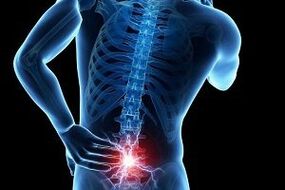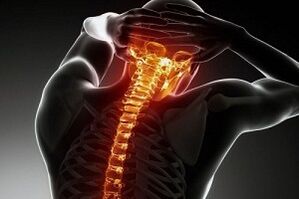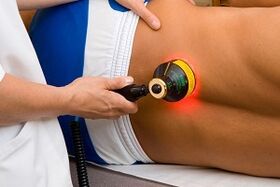
Osteochondrosis is a spinal pathology that affects millions of people of all ages.
Degenerative and dystrophic changes in the intervertebral discs, the proliferation of osteophytes cause a pain syndrome, reduce the mobility of the support column. Symptoms depend on the area affected.
In most cases, negative manifestations affect not only the supporting column and the paravertebral zone, but also spread to other areas.
Without treatment, the disease progresses, the work of organs and systems is disrupted, the state of health deteriorates noticeably, constant pain and complications against the background of pathology can lead to disability.
It is important to know what osteochondrosis is, the causes of a widespread disease, methods of treatment and prevention.
The reasons for the development of the disease

Degenerative and dystrophic processes in the intervertebral discs, excessive ossification in the affected area develops in the following cases:
- Back injuries;
- high load on the support post during hard work, professional sports, carrying loads;
- congenital defects of the supporting column;
- Lack of vitamins, minerals, deterioration in the quality of the upholstery;
- violation of mineral metabolism;
- hormonal disorders, endocrine diseases;
- Sedentary lifestyle, sedentary work;
- severe obesity;
- a decrease in the elasticity of the intervertebral discs in the elderly with the aging of the body;
- excessive consumption of strong coffee, carbonated and alcoholic drinks, acidic foods, smoked meat, smoking;
- Tumor process in the paravertebral zone, as a result of which the elastic structures of the spine are damaged.
Types and levels
Osteochondrosis affects all parts of the supporting column. Degenerative processes are more actively manifested in the mobile regions: the lumbar and cervical spine, in the thoracic spine, damage to the vertebrae, bone tissue is less common.
There are several types of osteochondrosis, depending on the area affected:
- cervical;
- Chest;
- lumbosacral.
Stages of pathology:
- First stage- the development of chondrosis. A lack of nutrients affects the quality of the intervertebral disc and the elasticity of the padding decreases. High loads against the background of the thinning of the cartilage tissue cause mild to moderate pain in the spine;
- second floor.Deformations of elastic structures are more pronounced, pain occurs not only with loads, but also when bending and twisting. The defeat of the annulus fibrosus leads to the pinching of sensitive structures, increased friction of the bone elements;
- third section.The integrity of the annulus fibrosus is broken, the intervertebral disc protrudes beyond the vertebra, the pain syndrome is pronounced. It is difficult for the patient to do without medication that alleviates the symptoms. Against the background of the destruction of the elastic pad, the mobility of the supporting column decreases, protrusions and intervertebral hernias develop;
- fourth stage.The cartilage layer is practically absent, osteophytes appear on the spine. Bone growth is an attempt to compensate for excessive stress on the affected vertebrae. Dense elements stabilize the spine, but at the same time reduce the mobility of the problem area of the support column. In the fourth stage of osteochondrosis, the pain decreases, but the patient has difficulty performing simple movements. Changes in the lumbosacral area can lead to paresis or paralysis of the lower body. Often in the fourth stage of osteochondrosis, the patient poses a disability.
On a note!The disease of the supporting column occurs with periods of remission (from several months to a year or more) and exacerbations (the duration of the relapse, the strength of the pain depends on many factors).
First signs and symptoms

The manifestation of the disease depends on the stage and the affected section.
The more negative factors, the higher the risk of pain syndrome and damage to other areas.
Blood circulation deteriorates, mineral metabolism is impaired, protrusions, vertebral hernias develop, excessive ossification occurs in the affected area.
Self-medication, lack of qualified help, combined with reluctance to regularly visit a vertebrologist, negatively affects the state of the vertebral structures.
Cervical
The main signs are:
- radicular syndrome with severe disc damage;
- pain in the back of the head, neck, crown;
- Dizziness, fainting;
- Headache;
- discomfort in the muscles of the shoulders, neck;
- Numbness of the cervical spine, hands, fingers;
- Chest discomfort;
- limited mobility of the cervical spine;
- Decrease or loss of reflexes in the shoulder muscles;
- feeling of "goose bumps" in hands, fingers;
- with osteochondrosis of the cervical spine, a person is tormented by insomnia, depressive states, irritability against the background of excruciating or painful neck pain and headache.
Osteochondrosis of the breast
Typical signs:
- with a long stay in one position, there are heavy loads, twists, bends, chest pain;
- with a deep breath, a discomfort of varying degrees is felt in the middle part of the back;
- when raising the arms, moving the body, the pain increases;
- with the progression of osteochondrosis of the chest region, problems arise in the work of the digestive tract;
- an uncomfortable feeling of "goose bumps" in the hands;
- Depending on the degree of damage, doctors distinguish dorsalgia - painful sensations of pain in the affected spine and back - acute, excruciating pain of high intensity, restricting breathing, causing muscle spasms;
- Intercostal neuralgia develops;
- painful or acute pain in the shoulder blades area;
- Reproductive disorders occur.
Lumbo-sacral region

The main symptoms are:
- Complaints of varying intensity in the lower back;
- Muscle weakness, development of paresis;
- Coldness and numbness of the lower extremities;
- the pain syndrome is pronounced with heavy loads or when lifting loads;
- painful lumbar lumbago occurs: pain radiates from the lower back to the buttock zone, groin, legs;
- Intermittent claudication developed;
- the compression of the nerves impairs the work of the pelvic organs: with a severe degree of lumbosacral osteochondrosis, urinary incontinence, involuntary bowel movements are possible;
- Fatigue occurs, it is difficult to stand, long walking provokes weakness in the legs.
diagnosis
To clarify the condition of the spine, you need to contact a vertebrologist. In the absence of a doctor of this specialization, you need to see a neurologist or orthopedic traumatologist.
Diagnostic measures:
- Examination of the patient, investigation of complaints.
- MRI.
- CT.
- X-ray of the spine in several projections.
- Doppler ultrasound of blood vessels.
- Electromyography.
Effective treatments
How to treat osteochondrosisChronic pathology requires the attention of both the doctor and the patient. Do not expect the negative symptoms to go away a week after starting the course of therapy. Only an integrated approach will produce results. The patient must understand that drugs alone cannot eliminate degenerative-dystrophic changes in the intervertebral discs and cannot prevent the proliferation of osteophytes.

For the successful treatment and prevention of osteochondrosis, it is important:
- conduct a complex of exercise therapy;
- attend massage and physiotherapy;
- To eat healthy food;
- organize a place to work and sleep, taking into account the recommendations of a doctor;
- Do not lift weights;
- regularly take vitamins and mineral complexes to maintain the elasticity of the intervertebral discs and the strength of bone tissue;
- refuse too intense training;
- avoid back injuries and bruises;
- monitor your weight.
There are other important rules:
- do not overcool;
- treat pathologies that affect the condition of the intervertebral discs;
- Taking breaks, warming up while working on the computer;
- move more, do physical education;
- refrain from excessive coffee and alcohol consumption, forget about smoking;
- Avoid prolonged static / dynamic loads;
- sleep on an orthopedic mattress and a low pillow;
- less nervous;
- plan at least 7 hours for a night's sleep;
- Regularly visit a vertebrologist, monitor the condition of the vertebral structures.
Medication
Effective groups and names:
- Chondroprotectors. . . They restore the cartilage tissue, slow down the process of destruction of the intervertebral discs. Course - 4 months or more;
- NSAIDs. . . The drugs relieve pain, remove swelling and inflammation. Local remedies work well: ointments, gels, plasters;
- B vitamins. . . The drugs restore nerve regulation, improve the nutrition of neurons, and reduce the severity of the pain syndrome. Injections (the first few days during an exacerbation) and tablets (for long treatment and prevention) are effective;
- Muscle relaxants. . . Means cope with muscle spasms, which are the main cause of pinching of nerve endings;
- Compositions that normalize blood circulation.Most often, drugs of this group are prescribed for cervical osteochondrosis, from which the brain suffers;
- Spinal blockages, Injection into the paravertebral zone. This type of exposure helps with excruciating lumbago and pain against the background of pinched nerves in the third or fourth stage of osteochondrosis. To increase the effect, corticosteroids and auxiliary substances are added to the analgesics;
- GCS group drugs.Steroid formulations are essential for severe pain. With lumbosacral osteochondrosis, injections are often prescribed, against the background of which painful lumbago develops.
Exercise and gymnastics
Exercises for the neck, lumbosacral and chest areas are prescribed after relieving acute pain and weakening the inflammatory process. Doctors have developed a complex of exercise therapy with different levels of stress for each zone.
The first sessions are carried out under the guidance of a physiotherapist. After studying the complex, the patient continues to exercise at home. It is important to note the duration and frequency of the sessions in order to achieve the therapeutic effect. In addition to physical education, vertebrologists recommend going to the swimming pool: swimming is an ideal type of positive effect on the spine.
Physiotherapeutic procedures

Effective methods of influencing:
- Ozokerite applications;
- Laser therapy;
- Radon and turpentine baths;
- Shock wave therapy;
- electrical procedures;
- Mud therapy;
- Phonophoresis and electrophoresis with drugs;
- Magnetic Therapy.
The following methods have good effects in treating osteochondrosis:
- Acupuncture;
- Hirudotherapy;
- Reflexology;
- Using a needle applicator;
- manual therapy;
- Dry and underwater traction of the spine;
- medical ipplicator.
It is quite difficult to prevent the development of osteochondrosis, but doctors advise to remember the factors that cause dystrophic and degenerative processes in the vertebral structures. The more attention a person pays to a healthy lifestyle, the lower the risk of developing negative changes in the intervertebral discs.

















































